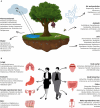Who inhabits the built environment? A microbiological point of view on the principal bacteria colonizing our urban areas
- PMID: 38863750
- PMCID: PMC11165352
- DOI: 10.3389/fmicb.2024.1380953
Who inhabits the built environment? A microbiological point of view on the principal bacteria colonizing our urban areas
Abstract
Modern lifestyle greatly influences human well-being. Indeed, nowadays people are centered in the cities and this trend is growing with the ever-increasing population. The main habitat for modern humans is defined as the built environment (BE). The modulation of life quality in the BE is primarily mediated by a biodiversity of microbes. They derive from different sources, such as soil, water, air, pets, and humans. Humans are the main source and vector of bacterial diversity in the BE leaving a characteristic microbial fingerprint on the surfaces and spaces. This review, focusing on articles published from the early 2000s, delves into bacterial populations present in indoor and outdoor urban environments, exploring the characteristics of primary bacterial niches in the BE and their native habitats. It elucidates bacterial interconnections within this context and among themselves, shedding light on pathways for adaptation and survival across diverse environmental conditions. Given the limitations of culture-based methods, emphasis is placed on culture-independent approaches, particularly high-throughput techniques to elucidate the genetic and -omic features of BE bacteria. By elucidating these microbiota profiles, the review aims to contribute to understanding the implications for human health and the assessment of urban environmental quality in modern cities.
Keywords: environmental niches; human health; human microbiota; microbial community; microbiomes; omic approaches; urban cities.
Copyright © 2024 Zampolli, De Giani, Rossi, Finazzi and Di Gennaro.
Conflict of interest statement
The authors declare that the research was conducted in the absence of any commercial or financial relationships that could be construed as a potential conflict of interest.
Figures




Similar articles
-
Microbiota of the indoor environment: a meta-analysis.Microbiome. 2015 Oct 13;3:49. doi: 10.1186/s40168-015-0108-3. Microbiome. 2015. PMID: 26459172 Free PMC article.
-
The roles of the outdoors and occupants in contributing to a potential pan-microbiome of the built environment: a review.Microbiome. 2016 May 24;4(1):21. doi: 10.1186/s40168-016-0165-2. Microbiome. 2016. PMID: 27216717 Free PMC article. Review.
-
Relative and contextual contribution of different sources to the composition and abundance of indoor air bacteria in residences.Microbiome. 2015 Dec 10;3:61. doi: 10.1186/s40168-015-0128-z. Microbiome. 2015. PMID: 26653310 Free PMC article.
-
Transfer of environmental microbes to the skin and respiratory tract of humans after urban green space exposure.Environ Int. 2020 Dec;145:106084. doi: 10.1016/j.envint.2020.106084. Epub 2020 Sep 22. Environ Int. 2020. PMID: 32977191
-
Transmission of Airborne Bacteria across Built Environments and Its Measurement Standards: A Review.Front Microbiol. 2017 Nov 29;8:2336. doi: 10.3389/fmicb.2017.02336. eCollection 2017. Front Microbiol. 2017. PMID: 29238327 Free PMC article. Review.
Cited by
-
Probiotic-Based Approaches for Sustainable Control of Infectious Risk in Mass Transport: Current Data and Future Perspectives.Microb Biotechnol. 2025 Jun;18(6):e70177. doi: 10.1111/1751-7915.70177. Microb Biotechnol. 2025. PMID: 40515692 Free PMC article. Review.
References
Publication types
LinkOut - more resources
Full Text Sources

